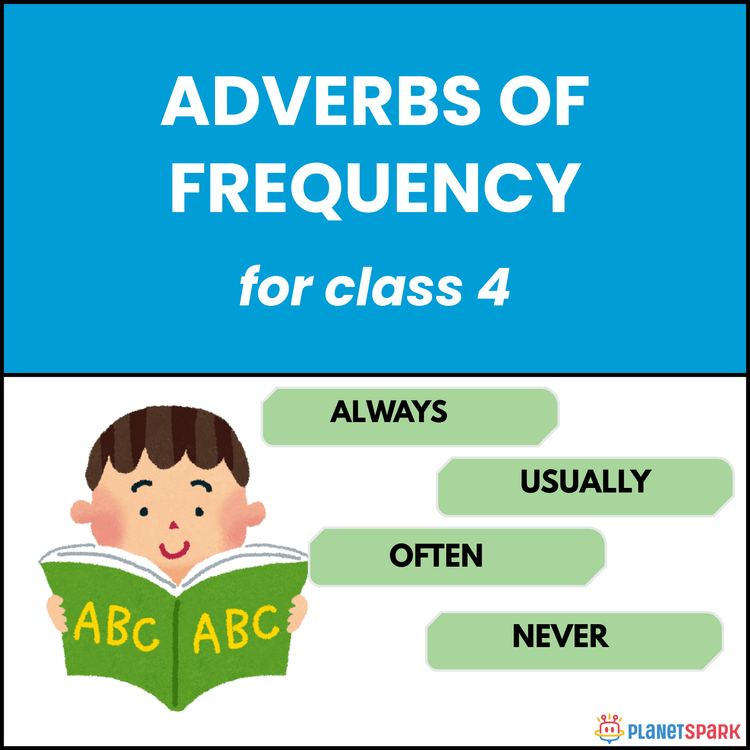Adverbs of Manner: Definition, Examples, and Worksheet

Table of Contents
- What Are Adverbs of Manner?
- Adverb of Manner Definition
- How to Identify an Adverb of Manner
- List of Common Adverbs of Manner
- Adverb of Manner Examples in Sentences
- Placement of Adverbs of Manner in Sentences
- Worksheet on Adverbs of Manner
- Difference Between Adverb of Manner and Other Adverbs
- Importance of Adverbs of Manner in English Grammar
- Common Mistakes with Adverbs of Manner
- Adverbs of Manner in Spoken English
- Real-World Examples for Kids
- Learn English Grammar with PlanetSpark
- Frequently Asked Questions (FAQs)
Understanding how an action happens is one of the most important parts of grammar. That’s exactly what adverbs of manner do. They describe how something is done, whether quickly, slowly, happily, or carefully.
In this detailed guide, you’ll learn everything about adverbs of manner, including their definition, examples in sentences, worksheets, and differences from other types of adverbs. Whether you’re a student, parent, or teacher, this blog will help you understand this topic clearly and use it correctly in daily conversations and writing.
What Are Adverbs of Manner?
An adverb of manner tells us how an action takes place. It describes the way or method in which something happens.
For example:
She sings beautifully.
He ran quickly to catch the bus.
The baby slept peacefully.
In each sentence, the adverb of manner modifies the verb by showing how the action is performed.
Adverbs of manner make your sentences more expressive and help the listener visualize the situation better.

Adverb of Manner Definition
An adverb of manner is a word that describes how an action is done. It modifies a verb, an adjective, or another adverb to show the quality or style of the action.
Definition:
“An adverb of manner describes the way or manner in which an action is performed.”
In simpler terms, it answers the question ‘How?’
Examples:
The teacher explained the lesson clearly.
The children played happily.
He spoke softly.
Here, clearly, happily, and softly describe the manner in which the actions were performed.
Want your child to master grammar easily?
Join PlanetSpark’s English Grammar Course and make learning fun.
How to Identify an Adverb of Manner
To identify an adverb of manner, look for a word that answers the question ‘How?’ in relation to the verb.
Examples:
| Sentence | Verb | Question | Adverb of Manner |
|---|---|---|---|
| She danced gracefully. | danced | How did she dance? | gracefully |
| He works hard. | works | How does he work? | hard |
| They laughed loudly. | laughed | How did they laugh? | loudly |
| The wind blew gently. | blew | How did the wind blow? | gently |
Most adverbs of manner end with -ly, such as quickly, slowly, softly, beautifully, and honestly. But some do not end with -ly, like well, fast, hard, late, early.
List of Common Adverbs of Manner
Here’s a useful list of adverbs of manner to enrich your vocabulary:
| Adverbs Ending in -ly | Adverbs Without -ly |
|---|---|
| Quickly | Well |
| Slowly | Fast |
| Carefully | Hard |
| Bravely | Late |
| Angrily | Early |
| Happily | Straight |
| Gently | Tight |
| Loudly | Wrong |
| Neatly | Right |
| Beautifully | Deep |
These adverbs can be used in various contexts depending on the verb and sentence type.
Turn grammar confusion into confidence.
Enroll your child in PlanetSpark’s live grammar classes today.
Adverb of Manner Examples in Sentences
Here are some adverb of manner examples sentences to help you understand their use better:
1. With Actions:
The dog barked loudly.
She answered politely.
The child smiled sweetly.
The teacher spoke firmly.
2. With Emotions:
He reacted angrily when he heard the news.
She hugged her mother tightly.
They laughed joyfully.
3. With Speed or Movement:
The athletes ran swiftly.
The car moved smoothly on the road.
The river flowed calmly through the valley.
4. In Negative or Cautious Situations:
He spoke rudely to his friend.
She walked nervously before her performance.
The man looked suspiciously at the stranger.
Each of these examples shows the manner in which the verb’s action is done
From adverbs to adjectives- make grammar simple.
Placement of Adverbs of Manner in Sentences
Usually, adverbs of manner come after the verb or after the object.
Examples:
He drives carefully.
She painted the picture beautifully.
They completed the project successfully.
If there is no object, the adverb follows the verb.
She sings well.
The children laughed loudly.
If there is an object, the adverb can come after it.
He opened the door quietly.
She read the story aloud.
Worksheet on Adverbs of Manner
Try this quick adverb of manner worksheet to test your understanding.
A. Fill in the blanks with suitable adverbs of manner:
The baby slept __________.
He completed his homework __________.
The teacher spoke __________ to the students.
The cat moved __________ through the grass.
She danced __________ at the function.
B. Identify the adverb of manner in each sentence:
The children played happily in the park.
He drives carefully in the rain.
They finished the work quickly.
The old man walked slowly.
The birds chirped sweetly in the morning.
C. Rewrite the sentences by changing the adverb of manner:
She sang beautifully. → She sang softly.
He spoke loudly. → He spoke gently.
The dog barked angrily. → The dog barked playfully.
Ready to boost your child’s grammar and confidence?
Enroll in PlanetSpark’s English Grammar Course and watch them fall in love with learning.
Difference Between Adverb of Manner and Other Adverbs
Adverbs are divided into different types based on what they describe — time, place, frequency, degree, or manner.
Here’s how adverbs of manner differ:
| Type | Question It Answers | Example | Function |
|---|---|---|---|
| Adverb of Manner | How? | She danced beautifully. | Describes how something happens |
| Adverb of Time | When? | She came yesterday. | Shows when an action happens |
| Adverb of Place | Where? | He lives nearby. | Shows location of action |
| Adverb of Frequency | How often? | He always wakes early. | Describes repetition |
| Adverb of Degree | To what extent? | She was very happy. | Shows intensity |
This comparison helps learners understand the specific role of adverbs of manner in grammar.
Importance of Adverbs of Manner in English Grammar
Adverbs of manner make communication more expressive and detailed. Without them, sentences sound dull and incomplete.
Why they matter:
Clarity: They make the meaning of verbs more precise.
“She spoke.” vs “She spoke softly.”
Expression: They show emotions and style.
“He smiled.” vs “He smiled happily.”
Creativity: They make writing and storytelling more vivid.
“The wind blew.” vs “The wind blew gently through the trees.”
For students, understanding adverbs of manner improves both writing and speaking skills.
Common Mistakes with Adverbs of Manner
Students often confuse adverbs of manner with adjectives or use them incorrectly.
1. Using Adjectives Instead of Adverbs:
❌ She sings beautiful.
✅ She sings beautifully.
2. Wrong Word Placement:
❌ He drives fastly.
✅ He drives fast.
3. Confusing ‘Hard’ and ‘Hardly’:
Hard means with effort.
Hardly means almost not.
✅ He works hard.
✅ He hardly sleeps.
Being careful with these differences is essential for accuracy.

Adverbs of Manner in Spoken English
Adverbs of manner are not just grammar terms — they are used every day in conversations:
“Please speak clearly.”
“He behaves politely.”
“Drive carefully.”
These expressions show tone, attitude, and feeling. Children who understand them can communicate more effectively.
Real-World Examples for Kids
Here are some fun examples using everyday activities:
The rabbit hops quickly.
The painter draws neatly.
The chef cooks skillfully.
The player kicks the ball powerfully.
These examples make the concept easy to remember and connect to real actions.

Learn English Grammar with PlanetSpark
At PlanetSpark, grammar becomes simple, interactive, and engaging. Our English Grammar Course helps kids understand tricky concepts like adverbs of manner, adjectives, tenses, prepositions, and conjunctions through fun games, live sessions, and real-world practice.
Instead of rote learning, children experience grammar through stories, examples, and guided speaking activities that make concepts stick for life.
Features of PlanetSpark’s Grammar Course
Live interactive classes with expert English teachers
Engaging worksheets, quizzes, and grammar games
Concept-based storytelling to make grammar fun and relatable
Personalized attention in small batch sizes
Progress reports and regular feedback for parents
Activity-based learning to connect grammar with real communication
Flexible scheduling for convenient learning at home
Why Choose PlanetSpark?
Because children don’t just memorize grammar rules, they understand, apply, and enjoy them. PlanetSpark helps kids transform grammar into a creative skill that strengthens writing, improves speaking, and boosts confidence.
👉 Give your child the power of strong English communication.
Frequently Asked Questions (FAQs)
1. What is an adverb of manner?
An adverb of manner tells how an action is performed. It describes the way something happens.
2. What are 10 examples of adverbs of manner?
Quickly, slowly, neatly, loudly, happily, carefully, gently, bravely, angrily, beautifully.
3. How do you identify an adverb of manner in a sentence?
Look for a word that answers the question “How?” and describes the verb’s action.
4. Can adverbs of manner come before the verb?
Rarely. Usually, they come after the main verb or object.
5. What is the difference between adverbs of manner and adjectives?
Adjectives describe nouns, while adverbs of manner describe verbs or actions.
6. What are 20 examples of adverbs of manner?
Quickly, slowly, carefully, happily, angrily, beautifully, softly, politely, bravely, gently, easily, loudly, quietly, neatly, rapidly, gracefully, skillfully, cheerfully, seriously, and badly.
7. What are the rules for using adverbs of manner?
Adverbs of manner usually come after the verb or the object they describe. Avoid placing them between the verb and its object.
Example:
✅ He spoke clearly.
❌ He clearly spoke the truth. (awkward)
8. Can an adverb of manner modify an adjective?
Yes, though rarely. For example: The story was beautifully written. Here, beautifully modifies written, showing how the writing was done.
9. What is the difference between an adverb of manner and an adjective?
An adjective describes a noun (person, place, or thing).
An adverb of manner describes a verb (action).
Example:
She is a beautiful singer. (adjective)
She sings beautifully. (adverb)
10. How do you form adverbs of manner?
Most adverbs of manner are formed by adding -ly to adjectives.
Quick → Quickly, Happy → Happily, Slow → Slowly.
However, some do not follow this rule, like fast, well, hard, late.
11. Can adverbs of manner come at the beginning of a sentence?
Sometimes yes, for emphasis or style.
Example: Slowly, she opened the door.
But the most common position is after the verb or object.
12. What is the adverb of manner in the sentence “He smiled happily”?
The adverb of manner is happily. It describes how he smiled.
13. Are all words ending with -ly adverbs of manner?
No. Some -ly words are adjectives (like friendly, lovely, silly). So, check if the word describes a verb — only then it’s an adverb of manner.
14. Can we use two adverbs of manner together?
It’s uncommon, but possible if they describe different aspects of the same action.
Example: She sang softly and beautifully.
15. What are some common adverbs of manner for kids to learn first?
Quickly, slowly, neatly, loudly, happily, carefully, bravely, nicely, gently, and quietly. These are simple, everyday examples children can easily understand and use.
Download Free Worksheets
Personalized Communication Report
Record a video to get a AI generated personalized communication report for your child

Hi There, want to try these
tips for your child with
LIVE with our expert coach?
Let's check your child's
English fluency



